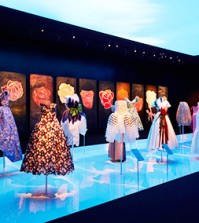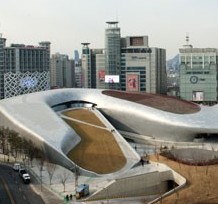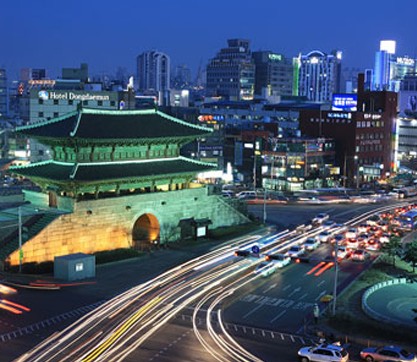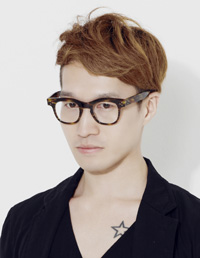- California Assembly OKs highest minimum wage in nation
- S. Korea unveils first graphic cigarette warnings
- US joins with South Korea, Japan in bid to deter North Korea
- LPGA golfer Chun In-gee finally back in action
- S. Korea won’t be top seed in final World Cup qualification round
- US men’s soccer misses 2nd straight Olympics
- US back on track in qualifying with 4-0 win over Guatemala
- High-intensity workout injuries spawn cottage industry
- CDC expands range of Zika mosquitoes into parts of Northeast
- Who knew? ‘The Walking Dead’ is helping families connect
New landmark at Dongdaemun to glitz up Seoul
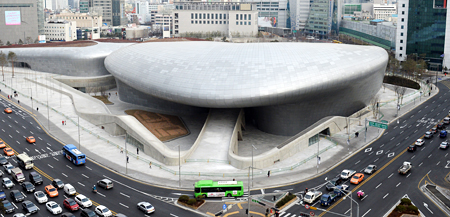
Dongdaemun Design Plaza, built on the former site of the Dongdaemun Baseball Stadium in northern Seoul, is scheduled to open to the public on March 21. (Korea Times photo by Shin Sang-soon)
By Joel Lee
Was it a good idea to demolish a historic baseball stadium in Dongdaemun in Seoul and build a multi-purpose museum and convention center there?
The answer to the question will be available soon as Dongdaemun Design Plaza, built on the site of the Dongdaemun Baseball Stadium, is scheduled to open to the public on March 21.
Some architects and professionals showed positive reaction to the new design plaza, which will function as a museum and convention center hosting exhibitions, international conferences, fashion shows, concerts, seminars and workshops.
First conceived in August 2006 as part of a redevelopment plan of the old ballpark, the DDP emerged under the ‘Design Seoul’ initiative of former Mayor Oh Se-hoon.
Now under Mayor Park Won-soon, it aspires to become a landmark structure in the area with the mission: “design with people.”
“At first, there were many concerns over the building’s identity. The biggest criticism came from its soaring cost (estimated at $450 million) which went far beyond the initial budget. Many architects felt the project should contribute to the development of Korean architectural culture,” said Professor Park Jong-hyuck of school of architecture at Seoul National University of Science and Technology.
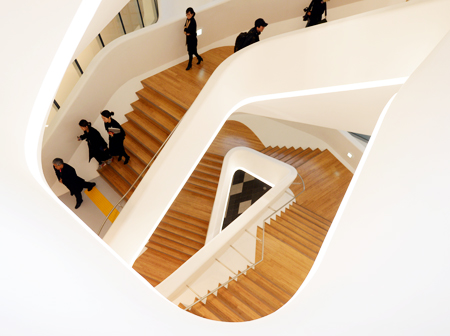
The inside of the world’s largest asymmetrical and freeform design plaza.
(Korea Times photo by Shin Sang-soon)
“Now that the construction is successfully completed, we should take advantage of the building’s enormous potential and value. This ‘masterpiece’ edifice will not only reflect but also enhance Seoul’s urban-architectural culture,” he aded.
The real allure of the building apparently comes from its own design.
Comprised of an art hall, museum, design lab, design market and park, with a total building area of 25,000 square meters, it is the world’s largest asymmetrical, freeform building with free-flowing curves made of 45,133 aluminum cladding panels.
The DDP was designed by Zaha Hadid, an Iraq-born British architect, who is the first female winner of the prestigious Pritzker Architecture Prize in 2004.
With a spaceship-like exterior and a milky-color interior, the DDP’s flexible design – dubbed “metonymic landscape” – is fashioned to express the “flow of liquid” for meeting a wide variety of functions.
The once-stadium-now-turned-park (Dongdaemun History & Culture Park) will be a public walkway accessible to all citizens.
In an email interview with The Korea Times, Zaha Hadid said, “As a catalyst for the instigation and exchange of ideas, (the DDP will) feed the cultural vitality and imagination of the city by fostering an ethos of collaboration between the government, businesses and the public.”
The DDP plans to operate various programs 24 hours a day in keeping with the bustling rhythm of Dongdaemun market and its merchants.
In addition, by tagging on “hallyu” or Korean Wave tourism, it aims to attract more tourists and link design-tourism to the Dongdaemun shopping quarters.
“We expect the so-called ‘DDP effect,’ meaning Gangbuk (northern Seoul) will significantly improve its image and street aesthetics and thereby reduce its cultural gap with relatively affluent Gangnam (southern Seoul),” said Yoon Dae-young, the director of Seoul Design Foundation, in a telephone interview.
The DDP plans to host a variety of exhibitions. Seoul Fashion Week is also scheduled with the opening.
Architecture and design experts agree that the development of proficient programs will be vital to the DDP’s long-term success.
“The DDP is such a magnificent work of architecture embodying many good philosophies about life. But are we really ready to embrace this masterpiece?” asked Amie Ahn, currently the invited curator at Seoul Museum of Art.
About the program, she added, “Things cannot be done overnight. We must be patient and develop a long-term perspective by valuing the process of forming consensus.”








